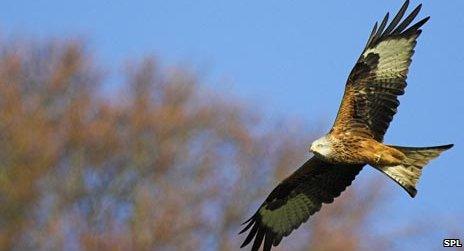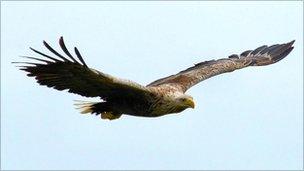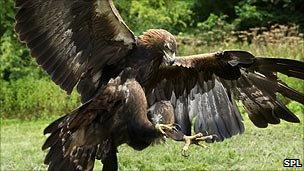Are birds of prey back?
- Published
- comments

Red kites are now a much more common sight
People are used to stories of conservational doom-and-gloom with fragile species threatened by creeping urbanisation, but recent reports suggest some birds of prey are booming in the UK. So why does the prospect of a soaring hawk or eagle leave some people worried?
Birds of prey are admired. Their powerful talons and soaring flight impresses. People relish the suspense that comes from watching them hover before making a kill.
Britain's biggest, the white-tailed (or sea) eagle - the fourth largest eagle in the world - has a wingspan of eight feet.
But during Victorian times many birds of prey were hunted ruthlessly. Four species - the osprey, white-tailed eagle, goshawk and marsh harrier - were virtually extinct in Britain during most of the 20th Century.
And some of their emotional resonance comes precisely because of their perilous decline during the period of intensive industrialisation in the UK.
During the 1950s and 1960s organochlorine pesticides were widely used, seriously inhibiting top predators like the golden eagle's ability to breed. But at the end of the 1960s these chemicals were banned.
That together with reintroduction schemes and a new ethos of protecting birds of prey - culminating in the 1981 Wildlife and Countryside Act - has turned the tide, says Grahame Madge, the Royal Society for the Protection of Birds' conservation spokesman.
The white tailed eagle, after a successful reintroduction scheme during the 1970s on the island of Rum is now well established in the west coast of Scotland.
The red kite is now up to 1,800 breeding pairs - a "staggering turn around", says Madge - while there are thought to be around 40,000 buzzards soaring over the UK. Everyone from hikers to motorway drivers can now expect to see birds of prey regularly.
But, it's neither a story of unbridled success or acceptance.
"It's a sweeping generalisation to say that birds of prey have bounced back," says Madge. "It may be fitting for some of the 15 species but not all."

Some farmers are worried by the spread of reintroduced eagles
Several species - notably the hen harrier, golden eagle and goshawk - are still at risk. In England there is only one breeding pair of golden eagles and 12 pairs of hen harriers when there should be many more, Madge says. There's plenty of food and territory, the problem is persecution, particularly poisoned bait, he says.
"Persecution was rife during the reign of Victoria. And we still see that mindset now with birds of prey being illegally persecuted in upland areas where you have grouse shooting, such as the Pennines and southern Scotland. "
A newspaper ran a spectacular photograph earlier this week, external of a golden eagle plucking a lamb from a field. Local farmers claimed the photograph was evidence that eagles - which have been reintroduced back into parts of Scotland - are now out of control.
The Scottish Crofting Federation is complaining that the reintroduction of the white-tailed eagle has been too successful. Donald Murdie, a crofter on the Isle of Skye and SCF consultant, says the bird has spread from its initial reintroduction to the west of the mainland, and the islands of Skye, Lewis and Harris.
"They're magnificent to behold. But whereas people were initially happy to see them, these birds are now causing serious problems to sheep producers."
Murdie says that the most seriously affected crofters complain they are losing 10 lambs a year. It's now time for a rethink, he argues.
"It would be fine if the reintroduction was kept to one discrete area but the fact is they're continuing to reintroduce in other areas like the East Coast and potentially Suffolk."
Others even allege that birds of prey are hoovering up the UK's songbirds. Keith McDougall, policy director of pressure group Songbird Survival, reels off a long list of species whose numbers are declining - the skylark down 51%, the song thrush down 48%, the tree sparrow down 89%. The reason is threefold, he says - intensive farming, a drier climate and an increasing number of predators.

There is only one breeding pair of golden eagles in England
This last category includes cats, crows, foxes but also birds of prey.
"In this country we're in the business of species balance - this is not the Serengeti plain, the Amazon or Antarctica. We're in a highly farmed environment so Songbird Survival believes that the management of species is important," says McDougall.
In the future that might mean extending its experimental cull of crows to birds of prey, he argues, a move that would require a change in the law.
"If things are going wrong for some birds it's the duty of those in charge to help species that are in trouble," he says.
But the RSPB says there is no evidence that birds of prey are to blame. Prof Ian Newton, visiting professor of ornithology at Oxford University, criticises Songbird Survival's claims.
"There's not a single piece of evidence to support the view that raptors are depressing songbird numbers," he says. "All the evidence points to changes in agricultural land use for the decline in songbird numbers."
Four factors - disappearance of weeds from fields, more efficient land drainage, intensive cutting of grass for silage and the loss of hedgerows - are to blame, Prof Newton says.
The awe that birds of prey inspire will continue to be a driver for conservation efforts.
"The golden eagle is pretty beautiful, the hen harrier stunning," says journalist Rod Liddle, who presented a radio programme this week on birds of prey.
"But my favourite memory is seeing an osprey at six o'clock in the morning one summer in Wiltshire. It was flying south, a big, black, white and brown bird. It was a magnificent sight."